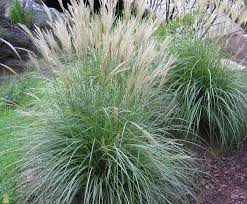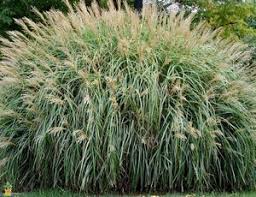Adagio Grass, scientifically known as Miscanthus sinensis ‘Adagio’, is a beautiful and popular ornamental grass that adds elegance to gardens and landscapes. With its graceful appearance and easy maintenance, Adagio Grass is a favorite among garden enthusiasts.
This type of grass is characterized by its compact size and clumping growth habit. It usually reaches a height of about 3 to 4 feet (0.9 to 1.2 meters) and forms neat, dense tufts of foliage. The leaves are slender, narrow, and a vibrant green color, creating a soothing and calming effect in outdoor spaces.
One of the outstanding features of Adagio Grass is its ability to sway gracefully in the breeze, giving movement and life to your garden. The feathery plumes that rise above the foliage during late summer and fall add an extra touch of visual interest. These plumes start off with a reddish hue and gradually fade to a soft silvery-white, creating a captivating contrast against the green leaves.
Adagio Grass is incredibly versatile and can be used in various ways to enhance your landscape. It works well as a border plant, edging along walkways, or as an accent in rock gardens. Its compact size makes it suitable for smaller gardens or even container planting. Additionally, this grass is relatively low-maintenance, making it a great choice for both experienced and novice gardeners.
To grow Adagio Grass successfully, choose a sunny location with well-draining soil. Plant them at a distance of about 2 to 3 feet apart to allow enough space for their clumping habit. Water the grass regularly during its initial establishment period, and once it’s established, it can tolerate periods of drought.
Come autumn, Adagio Grass provides an exquisite show as its plumes catch the sunlight and sway gently in the wind. You can leave these plumes intact throughout the winter, adding texture and interest to your garden during the colder months. When spring arrives, trim back the old growth to make way for new growth to emerge.
However, Adagio Grass, or Miscanthus sinensis ‘Adagio’, is a splendid ornamental grass that brings a sense of grace and tranquility to any garden or landscape. Its compact size, elegant appearance, and low-maintenance nature make it a sought-after choice among gardeners. Whether you’re looking to create a border, add movement, or simply enjoy the beauty of a well-designed garden, Adagio Grass is a wonderful option to consider.
Read Also: The Recommended Site for Sitting your Fish Farm
Growing Adagio Grass

Here’s a comprehensive growing guide for Adagio Grass (Miscanthus sinensis ‘Adagio’):
1. Choosing the Right Location: Select a sunny location in your garden that receives at least 6 to 8 hours of direct sunlight daily. Adagio Grass thrives in full sun and may not perform well in shaded areas.
2 Soil Preparation: Ensure the soil is well-draining to prevent waterlogging, which can be detrimental to the grass. If the soil is heavy or compacted, consider amending it with organic matter such as compost to improve drainage.
3. Planting:
Planting Time: The best time to plant Adagio Grass is in spring or early fall. This gives the grass enough time to establish its roots before facing extreme temperatures.
Spacing: Plant each Adagio Grass clump about 2 to 3 feet apart to allow for its clumping growth habit to develop.
Planting Depth: Dig a hole slightly larger than the root ball of the grass clump. Place the grass in the hole at the same depth it was in its nursery container.
4. Watering:
Establishment Period: Water the newly planted Adagio Grass regularly to keep the soil consistently moist, but not waterlogged, during its first growing season.
Established Plants: Once the grass is established, it becomes more drought-tolerant. Water deeply but infrequently, allowing the top inch or so of soil to dry out between waterings.
5. Fertilizing: Adagio Grass generally doesn’t require heavy fertilization. A light application of balanced, slow-release fertilizer in spring is usually sufficient. Avoid over-fertilizing, as this can lead to excessive leaf growth and less flowering.
6. Pruning and Maintenance:
Spring: In early spring, before new growth emerges, cut back the old foliage to about 6 inches above the ground. This helps stimulate new growth and improves the overall appearance of the grass.
Fall: You can leave the ornamental plumes on the grass throughout the winter to provide visual interest. Trim them back in late winter or early spring before new growth starts.
7. Pest and Disease Management: Adagio Grass is relatively resistant to pests and diseases. However, keeping the area around the grass clean and free of debris can help prevent any potential issues.
8. Winter Care: The grass is hardy and can survive cold winters. However, in areas with severe winters, applying a layer of mulch around the base of the grass in late fall can provide some protection to the roots.
8. Propagation: You can propagate Adagio Grass through division. Every few years, dig up the clump in early spring, divide it into smaller sections, and replant them. This helps rejuvenate the plant and maintain its health.
By following this growing guide, you can enjoy the beauty and elegance of Adagio Grass in your garden while keeping it healthy and thriving throughout the seasons. Remember that each garden is unique, so observing your plants and adjusting care based on their specific needs is essential for successful growth.
Caring for Adagio Grass
Here’s a comprehensive caring guide for Adagio Grass (Miscanthus sinensis ‘Adagio’):
1. Watering:
Establishment Phase: Water the grass regularly during its first growing season to help establish a strong root system. Keep the soil consistently moist but not waterlogged.
Mature Plants: Once established, Adagio Grass is relatively drought-tolerant. Water deeply and less frequently, allowing the top inch or two of soil to dry out between waterings.
2. Soil and Fertilization:
Soil Type: Adagio Grass prefers well-draining soil. Amend heavy or compacted soil with organic matter to improve drainage.
Fertilizing: Apply a balanced, slow-release fertilizer in early spring to promote healthy growth. Avoid over-fertilization, as this can lead to excessive foliage growth and reduced flowering.
3. Pruning:
Spring Pruning: In early spring, trim back the old foliage to about 6 inches above the ground before new growth emerges. This tidies up the appearance and encourages vigorous new growth.
Fall Pruning: You can leave the ornamental plumes on the grass throughout the winter for visual interest. Prune them back in late winter or early spring before new growth begins.
4. Mulching: Applying a layer of mulch around the base of the grass in late fall can help protect the roots from extreme cold temperatures. However, avoid piling mulch directly against the crown of the plant.
5. Pest and Disease Management: Adagio Grass is relatively resistant to pests and diseases. Keep the area around the grass clean and free of debris to prevent potential issues.
Keep an eye out for signs of pests like aphids or grasshoppers and take action if necessary.
6. Winter Care: Adagio Grass is hardy and can withstand cold winters. However, in areas with severe winter weather, providing some mulch around the base of the plant can offer additional protection.
7. Division: Over time, Adagio Grass can become crowded. Every few years, consider dividing the grass in early spring to maintain its health and vigor.
Dig up the clump, separate it into smaller sections using a sharp shovel or knife, and replant the divisions.
8. Container Care: Adagio Grass can be grown in containers, which is ideal for small gardens or balconies.
Choose a large container with drainage holes, use a well-draining potting mix, and water regularly to prevent the soil from drying out completely.
9. Pest and Disease Management: Adagio Grass is relatively resistant to pests and diseases. However, keep an eye out for any signs of stress, discoloration, or unusual growth, and address them promptly.
Remember, while this caring guide provides general guidelines, individual growing conditions can vary. Observing your Adagio Grass regularly and adjusting care as needed will help you maintain healthy and vibrant plants in your garden or landscape.
Read Also: Types of Fishing Methods
Adagio Maiden Grass

Adagio Maiden Grass is a lovely grass plant that brings beauty to gardens. Its scientific name is Miscanthus sinensis ‘Adagio’. This grass has pretty leaves that move gently in the wind, making the garden feel alive.
With its soft green leaves, Adagio Maiden Grass is a charming addition to outdoor spaces. It grows in clumps and reaches about 3 to 4 feet tall. During late summer and fall, it grows delicate plumes that change from reddish to a silvery-white color, making the garden look even more magical.
This grass is easy to grow and doesn’t need much care. Plant it in a sunny spot with soil that drains well. When it’s young, give it water regularly to help it grow strong roots. As it gets older, it can handle dry periods better.
Adagio Maiden Grass is like a dance partner in the garden, swaying gracefully in the breeze. It doesn’t need a lot of pruning, but in spring, you can trim the old leaves to make space for new ones. Leave the pretty plumes on during winter, and when spring arrives, cut them back.
People love to use Adagio Maiden Grass in different ways. It can be planted as a border along paths or even in pots. It adds a touch of elegance wherever it grows.
In simple words, Adagio Maiden Grass is a beautiful plant with soft leaves and swaying plumes. It’s easy to care for and makes gardens look even more wonderful.
Read Also: Types of Marketing Channels
